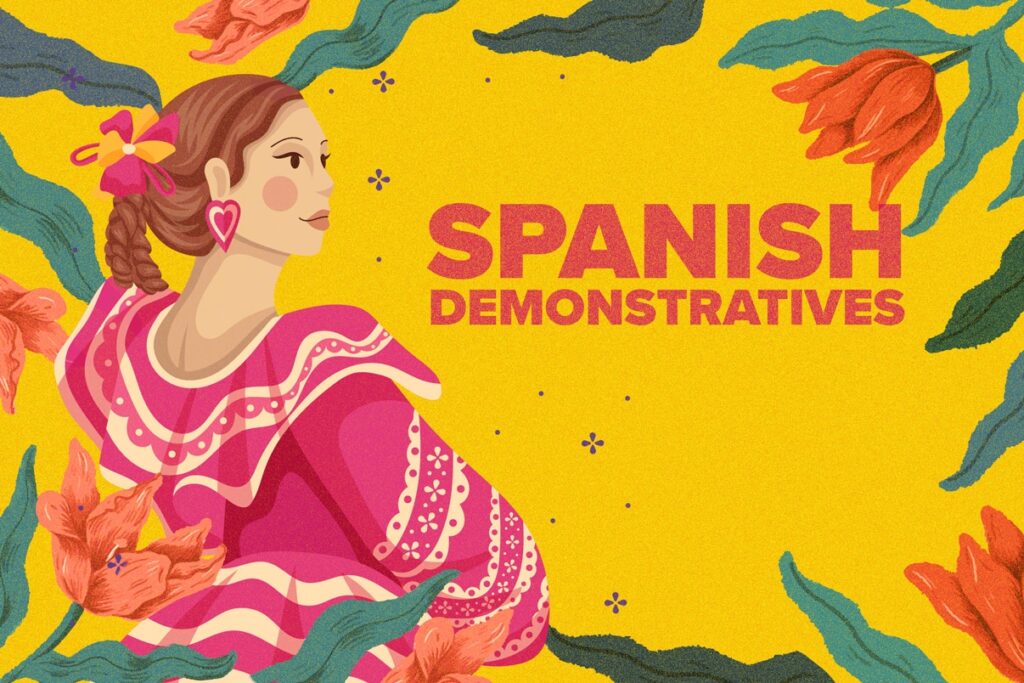Spanish Demonstrative Adjectives and Pronouns

Spanish demonstratives—words like this, that, these and those—are used in nearly every conversation and are extremely helpful for Spanish learners. Knowing them won’t just help you get around in Spain or Latin America without resorting to hand gestures and pointing, but they’re also key to understanding countless conversations.
In this post, you’ll learn all six Spanish demonstrative adjectives and pronouns and how to use them like a native speaker.
Download: This blog post is available as a convenient and portable PDF that you can take anywhere. Click here to get a copy. (Download)
What Are Demonstratives?
Demonstratives are words like “this,” “that” and “that over there.” And when plural, they become “these,” “those” and “those over there.”
Demonstratives are always either pronouns or adjectives.
A demonstrative is an adjective when it describes a noun. An example of an English demonstrative adjective would be:
That house is beautiful.
This dress is expensive.
A demonstrative pronoun replaces the noun and should only be used when it’s already clear what you’re talking about (either from what you’ve previously said or from a gesture, like pointing at something). For example:
That is beautiful. (Referring to the house)
This is expensive. (Referring to the dress)
Spanish Demonstratives: Adjectives vs. Pronouns
Understanding the difference between a demonstrative adjective and a demonstrative pronoun can be tricky, but here’s it put simply: the adjective describes a noun, whereas the pronoun replaces a noun.
There are six demonstratives in Spanish, and they can be used as either pronouns or adjectives just like the English demonstratives we saw above:
- Esto — this
- Estos — these
- Eso — that
- Esos — those
- Aquello — that over there
- Aquellos — those over there
Using the same examples we saw in English, a demonstrative adjective would be used in Spanish like this:
Esa casa es hermosa. — That house is beautiful.
Este vestido es caro. — This dress is expensive.
Since demonstrative pronouns replace the noun, these sentences would turn into:
Esa es hermosa. — That is beautiful. (Referring to the house).
Este es caro. — This is expensive. (Referring to the dress).
Spanish Demonstrative Adjectives
When using Spanish demonstratives as adjectives, they must follow the same rules normal adjectives follow—such as gender and pluralization agreement.
Take a look at each demonstrative in its masculine and feminine forms:
Let’s look at some examples to understand when and how to use them.
¿Cuánto cuestan estas manzanas? — How much do these apples cost?
(The apples are very close)
¿Cuánto cuestan esas manzanas? — How much do those apples cost?
(The apples are nearby, but not within easy reach)
¿Cuánto cuestan aquellas manzanas? — How much do those apples over there cost?
(The apples are far away and you can’t reach them)
You’ll also need to change the demonstrative based on how long ago something happened. For example:
¡Este artículo es muy interesante! — This article is very interesting!
(The article is right in front of you on your laptop)
¿Has leído ese artículo que te envié? — Have you read that article that I sent you?
(It’s been a day or a few since you sent the article to your friend)
¿Te acuerdas de aquel artículo sobre los demonstrativos? — Do you remember that one article about demonstratives?
(You sent the article a month or more ago)
En aquel tiempo era diferente. — Back then things were different.
(Something happened a very long time ago)
Here’s a story-based lesson from our YouTube channel to help you nail demonstrative adjectives:
Spanish Demonstrative Pronouns
Demonstrative pronouns don’t come before nouns like adjectives because they entirely replace them. In English, we use them in sentences like “how much is this?” and “those are expensive.”
In Spanish, the masculine and feminine demonstrative pronouns are the same as the adjectives we’ve already seen, but with the addition of a neutral pronoun.
These are great for when you have no idea what the gender of the noun you’re referring to is.
| English | Masculine | Feminine | Neutral |
|---|---|---|---|
| This | Este | Esta | Esto |
| These | Estos | Estas | |
| That | Ese | Esa | Eso |
| Those | Esos | Esas | |
| That (over there) | Aquel | Aquella | Aquello |
| Those (over there) | Aquellos | Aquellas |
(Note that if you come across accent marks on these pronouns, that’s because historically, they included them. And sometimes, the accent marks can clarify that the demonstrative is acting as a pronoun and not an adjective if there’s any chance of confusion.)
Let’s look at some common examples:
Dame uno de estos, por favor. — Give me one of these please.
¿Qué es eso? — What is that?
No, esos no. Quiero aquellos de ahí. — No, not those. I want the ones way over there!
When you need to use an adjective with a neutral pronoun, the adjective will be masculine. For example:
Eso es bueno. — That is good.
As with the adjective forms, demonstrative pronouns can describe immaterial things. Take a look at the following situations:
Eso me suena. — That sounds familiar to me. (i.e. a song, idea, invention, etc.)
Esto es una locura. — This is craziness.
Aquello es bonito. — That thing over there is pretty.
Some very common expressions make use of these pronouns, too:
- ¡Eso! — That’s it! (Someone’s given you the right answer.)
- ¿Como va eso? ¿Estás avanzando? — How is that going? Are you making progress? (At work)
- Por eso / aquello — That’s why
- A eso de las 15:00 — At about 3 p.m.
- Aparte de eso — Besides that
- ¿Y eso qué? — So what?
- ¿De dónde sacaste eso? — Where did you get that (idea) from?
- Dicho esto — That (being) said
- Con esto en mente — With this in mind
- Esto sí es vida — This really is the life
- Todo esto y más — All this and more
- Aquello se está animando — Things are getting lively
Demonstratives are so important that you’ll hear them in almost every conversation, whether as adjectives, pronouns or in phrases like those above.
One of the best ways to master Spanish concepts like demonstratives is by using a learning program that focuses on immersion and learning in context, like FluentU.
FluentU takes authentic videos—like music videos, movie trailers, news and inspiring talks—and turns them into personalized language learning lessons.
You can try FluentU for free for 2 weeks. Check out the website or download the iOS app or Android app.
P.S. Click here to take advantage of our current sale! (Expires at the end of this month)

Spanish Demonstrative Practice Quiz
Now that you’ve learned everything you need about Spanish demonstratives, it’s time to put theory into practice!
Complete the Spanish sentence by choosing the right demonstrative based on the English sentence. Remember to ensure it agrees with the noun’s gender and quantity!
1. ___ chica habla español con fluidez. — That girl over there speaks Spanish fluently.
2. ___ sabe mal. — This (singular, feminine) tastes bad.
3. ___ me parece bien. — That (singular, neutral) sounds good to me.
4. Quisiera ___ tres bebidas, por favor. — I would like these three drinks, please.
5. ___ edificio es demasiado peligroso. — That building is too dangerous.
6. ___ niño está enfermo. — This boy is sick.
7. No quiero ___, quiero ___. — I don’t want those (masculine), I want those over there (masculine).
8. ___ país es mi favorito. — This country is my favorite.
9. ¿Escuchaste ___ canción que te mandé? — Did you listen to that song [a few days ago] that I sent you?
10. Me gusta más ___. — I like this one [singular, masculine] the best.
Answers:
1. Aquella chica habla español con fluidez.
2. Esta sabe mal.
3. Eso me parece bien.
4. Quisiera estas tres bebidas, por favor.
5. Ese edificio es demasiado peligroso.
6. Este niño está enfermo.
7. No quiero esos, quiero aquellos.
8. Este país es mi favorito.
9. ¿Escuchaste esa canción que te mandé?
10. Me gusta más este.
That’s it for our complete roundup of Spanish demonstratives.
With these six simple words under your belt, you’ll find understanding Spanish sentences much easier.
Download: This blog post is available as a convenient and portable PDF that you can take anywhere. Click here to get a copy. (Download)
And One More Thing…
If you've made it this far that means you probably enjoy learning Spanish with engaging material and will then love FluentU.
Other sites use scripted content. FluentU uses a natural approach that helps you ease into the Spanish language and culture over time. You’ll learn Spanish as it’s actually spoken by real people.
FluentU has a wide variety of videos, as you can see here:

FluentU brings native videos within reach with interactive transcripts. You can tap on any word to look it up instantly. Every definition has examples that have been written to help you understand how the word is used. If you see an interesting word you don’t know, you can add it to a vocab list.

Review a complete interactive transcript under the Dialogue tab, and find words and phrases listed under Vocab.

Learn all the vocabulary in any video with FluentU’s robust learning engine. Swipe left or right to see more examples of the word you’re on.

The best part is that FluentU keeps track of the vocabulary that you’re learning, and gives you extra practice with difficult words. It'll even remind you when it’s time to review what you’ve learned. Every learner has a truly personalized experience, even if they’re learning with the same video.
Start using the FluentU website on your computer or tablet or, better yet, download the FluentU app from the iTunes or Google Play store. Click here to take advantage of our current sale! (Expires at the end of this month.)







